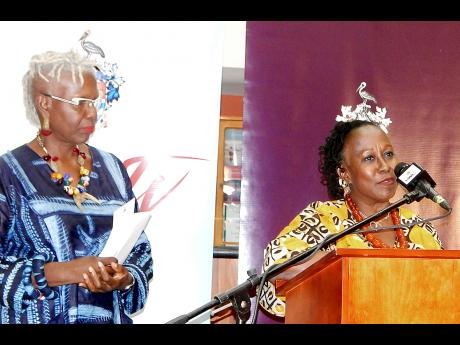For the Reckord | Opal Palmer Adisa a multifaceted writer, performer
Opal Palmer Adisa not only writes in many genres (novel, essay, lecture, article, poetry and short story), but, being a storyteller and performance poet, she also often performs what she writes. She wasn't in performance mode, though, on the evening of February 15 when her latest collection of fiction, Love's Promise, was launched at the University of the West Indies' Regional Headquarters, Hermitage Road.
There, she mainly confined herself to reading her stories, while two young women, Nerissa Mourillon and Cailia Adams, danced their interpre-tation of the tales. Among the other people who spoke were the witty emcee, Dr Carolyn Cooper; UWI Vice-Chancellor Sir Hilary Beckles, two university lecturers (Dr Isis Semaj-Hall and Lisa Tomlinson) and poet Ann-Margaret Lim.
All were enthusiastic in their praise for the book and Palmer Adisa's creative writing, generally, and the 100-plus dressed-up people at the formal event got a fairly good overview of Palmer Adisa's interests. However, it was on the following afternoon, in a university classroom with an audience of a dozen or so lecturers and students, that Palmer Adisa got up close and personal and, for me, more revealing.
Laughter-filled hour
After an introduction by senior lecturer in the Department of Literatures in English, Dr Anthea Morrison, Palmer Adisa took the floor and, in a laughter-filled hour and a half, took us on her journey from being an ordinary girl growing with the cane in Caymanas, St Catherine, to becoming a much-travelled writer, university professor, feminist and activist.
For 23 years, she was a distinguished professor at California College of the Arts, and she has been a visiting professor at several universities, including Stanford and the University of California at Berkeley. Her poetry, stories, essays and articles have appeared in more than 400 journals, anthologies and other publications, but it was The Gleaner that first published her poems, between 1977 and 1980. Having returned to Jamaica last August, she is now the director of the UWI's Institute of Gender and Development Studies.
In a very animated manner, she read, performed and commented on a selection of her poems, some written in standard English, some - because of Louise Bennett's influence - in Jamaica's "nation language". First, she read the imagery-packed Market Woman, describing it as a celebration of Jamaican women which shows both their tart tamarind side and the sweet, juicy-mango side.
Widely read
She said she has "always been concerned primarily with the Jamaican working-class woman ... with giving voice to the voiceless," and underlined her focus on the average person with the statement, "Anyone with a fifth-grade education can read my work... I want my work to be read widely."
She spoke about how, when she was 13, she would go with her mother to help the needy at the Spanish Town Hospital. Her mother had volunteered to work with Red Cross, as she believed in giving back to the less privileged. It was that altruistic way of living, Palmer Adisa said, that shaped her writing.
She spoke, too, of her love of plants, and, from a collection of the same name, read Leaf of Life, unabashedly proclaiming it "a brilliant poem". Happily, after she read the poem, which is about the many uses the leaf-of-life plant can be put to, the audience seemed to agree with her.
She spoke and read about her disgust at the abuse of woman and children, and of her interest in politics - revealing she "wanted to be a revolutionary" and had thought of going to Grenada in the 1980s and working with Maurice Bishop's New Jewel Movement.
She told an anecdote showing the society's class division, which was "troubling" to her. When she lived at Caymanas Estate, the upper-class people there were British and they would hold Christmas parties which the black middle class was allowed to go. Palmer Adisa's mother told her that one friend couldn't go to a party with her because the girl was the daughter of the family's helper, at the time called "the maid".
Hilariously, she spoke about graffiti and sex, and related it to her love of language - to words as her muse and lover. She said that her most famous essay, How I Became a Writer, had been much anthologised and had made her more money than most of her books.
"Writing is my weapon," she read from one poem. "I aim it now."




